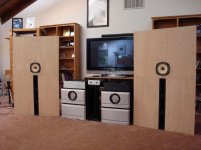Has anyone put an AMT in a Ripole enclosure?
I would be surprised if this hasn't been considered. I found a thread on ESL AMT, which touched on ESL in a Ripole - close but not quite.
If it works, the narrow slot opening would give you the wide horizontal dispersion of a narrow ribbon independent of the surface area of the membrane.
I suppose you might get some sort of cavity resonance, but I think that would be easy to fix w/ a filter. Would you lose SPL? Would this become a compression driver and require a horn?
What am I missing?
I would be surprised if this hasn't been considered. I found a thread on ESL AMT, which touched on ESL in a Ripole - close but not quite.
If it works, the narrow slot opening would give you the wide horizontal dispersion of a narrow ribbon independent of the surface area of the membrane.
I suppose you might get some sort of cavity resonance, but I think that would be easy to fix w/ a filter. Would you lose SPL? Would this become a compression driver and require a horn?
What am I missing?
With a ripole being a variant of a dipole, you'd have to start with an open-back AMT, would you not?
Yup. Many are, off the shelf.
I think there may be some constraints on the proportions of the cavity, but I don't understand them. I read something about a 10:1 limit but couldn't figure out which dimensions those applied to, or what that implied for the third dimension.
I think there may be some constraints on the proportions of the cavity, but I don't understand them. I read something about a 10:1 limit but couldn't figure out which dimensions those applied to, or what that implied for the third dimension.
What frequency range? Would two HF units firing directly towards each other (such is a ripole) work?
I don't know about ripole ...
but Nelson has a neat article about the slot OB he first developed long ago at AMT and some modern, recent updates with graphs!
www.firstwatt.com/pdf/art_slob.pdf
With Lowther

but Nelson has a neat article about the slot OB he first developed long ago at AMT and some modern, recent updates with graphs!
www.firstwatt.com/pdf/art_slob.pdf
With Lowther

Last edited:
The first part of that article about the low-frequency version essentially describes the LAT (Linear Array Transducer) that is no longer made (by Tymphany). I have a couple of those smaller ones laying around that I was selling. Little did I know they were AMT's all along. 🙂
An externally hosted image should be here but it was not working when we last tested it.
Interesting stuff!
I'd seen that Pass paper before. On re-reading I see a dimensional constraint in the cavity depth/half-wave cancellation he describes. This should also apply to AMT pleat depth and HF extension. Let's not forget that an AMT is also a stacked Ripole.
The Tymphany LAT spec's show a HF limit corresponding to the half wave cancellation for the driver diameter.
So if you put an AMT in a Ripole enclosure, the width of the AMT will set the half wave cancellation frequency. 1" -> 6.75 kHz, 2" -> 3.38 kHz. That kills things if you want a tweeter, but leaves the door open to LF.
As far as I can tell, AMTs don't have a lower resonant limit like dynamic drivers and their impedance is flat. The response just drops w/ frequency based on surface area. So if you started stacking AMT Ripoles... how low could you go?
Some quick math based on SPL suggests ~50 would equal the swept volume of an 8" woofer, and incidentally occupy about the same space. Taking the output from the edge simplifies the magnet structure, stacking them lets you share magnets (half as many), and an array of this number would boost your sensitivity by about 16 dB so you could use weaker (cheaper) magnets.
The reason this won't work is.... ?
I'd seen that Pass paper before. On re-reading I see a dimensional constraint in the cavity depth/half-wave cancellation he describes. This should also apply to AMT pleat depth and HF extension. Let's not forget that an AMT is also a stacked Ripole.
The Tymphany LAT spec's show a HF limit corresponding to the half wave cancellation for the driver diameter.
So if you put an AMT in a Ripole enclosure, the width of the AMT will set the half wave cancellation frequency. 1" -> 6.75 kHz, 2" -> 3.38 kHz. That kills things if you want a tweeter, but leaves the door open to LF.
As far as I can tell, AMTs don't have a lower resonant limit like dynamic drivers and their impedance is flat. The response just drops w/ frequency based on surface area. So if you started stacking AMT Ripoles... how low could you go?
Some quick math based on SPL suggests ~50 would equal the swept volume of an 8" woofer, and incidentally occupy about the same space. Taking the output from the edge simplifies the magnet structure, stacking them lets you share magnets (half as many), and an array of this number would boost your sensitivity by about 16 dB so you could use weaker (cheaper) magnets.
The reason this won't work is.... ?
- Status
- Not open for further replies.
- Home
- Loudspeakers
- Planars & Exotics
- AMT in a Ripole enclosure?